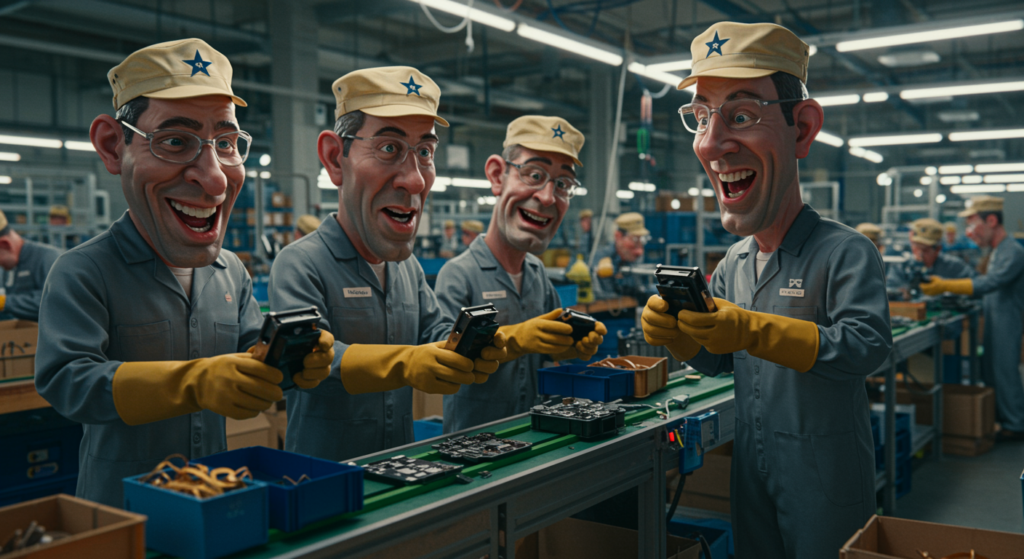
Chinese AI Video Exposes Truth on US Manufacturing Revival
Chinese AI Video Sparks Global Debate on US Manufacturing Revival
Have you ever wondered how a simple video could highlight the struggles of bringing factories back home? A series of AI-generated videos from China, depicting American factory workers in exaggerated, unflattering scenarios, has exploded on social media, forcing a worldwide conversation about the real hurdles in US manufacturing revival. These clips, which started circulating in April 2025, show tired, overburdened Americans in mock sweatshops assembling goods like iPhones—mirroring China’s own production lines—and they’re directly tied to the rising US-China trade tensions.
Imagine the irony: these videos surfaced right after President Trump’s tariffs on Chinese imports hit 145%, a bold move in his push for US manufacturing revival. China fired back with 125% tariffs on US goods, signaling they’re done playing the tariff game. It’s a stark reminder that US manufacturing revival isn’t just about policy; it’s about the global economic ripple effects that affect everyday lives.
Inside the Controversial AI Videos
One standout video by TikTok user Ben Laauo paints a vivid picture of Americans in gray uniforms, slaving away on assembly lines to the tune of traditional Chinese music. Workers look defeated—one even snacks on a burger mid-shift—ending with Trump’s “Make America Great Again” slogan flashing on screen, subtly mocking the promises of US manufacturing revival.
After it hit X (formerly Twitter) via user Damon Chen, the video racked up over 6 million views. Other memes, like one showing a finance pro crying over a sewing machine under Trump’s watchful eye, add to the satire. These portrayals aren’t just funny; they challenge the feasibility of US manufacturing revival by flipping the script on who does the hard labor.
Divergent Public Reactions
Reactions to these videos are split, with people on both sides of the Pacific weighing in passionately.
Defenders of Factory Work
Many Americans feel these videos belittle the dignity of factory jobs. For instance, one user shared how their mom held a sewing factory job for 15 years, providing stability for the family—it’s a heartfelt defense that makes you think about the human side of US manufacturing revival.
- A commenter noted: “My dad built circuit boards on Long Island in the 1990s; it was the backbone of our middle-class life.”
- These stories remind us that behind the satire, real people have relied on these roles.
Critics Highlighting US Manufacturing Revival Challenges
On the flip side, some see the videos as a wake-up call to the obstacles in US manufacturing revival. Critics argue that low-skill jobs won’t return easily, especially with education systems falling short on training for high-tech roles.
- One person pointed out: “iPhones might soon cost $5,000 without a charger if we try to force US manufacturing revival.”
- Others call it propaganda but admit it spotlights issues like China’s labor practices.
What do you think—do these videos exaggerate or expose a deeper truth?
The Economic Reality Behind the Satire and US Manufacturing Revival
While the videos are over-the-top for effect, they tap into genuine issues with US manufacturing revival efforts against a backdrop of intensifying trade wars. Despite adding about 800,000 workers in recent years, manufacturing still only accounts for 11% of US GDP, and experts warn of ongoing challenges.
Current State of US Manufacturing
Commerce Secretary Howard Lutnick boasts of “trillions” in potential investments for US manufacturing revival, but he admits many new factories will be automated. This means fewer traditional jobs and more reliance on tech-savvy workers, which raises questions about who really benefits.
It’s a scenario that feels far from the campaign promises—think about a factory where robots do most of the work, leaving humans to oversee rather than assemble.
The Automation Factor in US Manufacturing Revival
Modern manufacturing is leaning heavily on robots, making the videos’ human-focused mockery somewhat outdated. If US manufacturing revival happens, it might look like high-tech hubs with a small team of experts, not vast lines of workers. This shift could be a game-changer, but it also highlights the need for better training programs to prepare people for these roles.
The Evolving US-China Trade Relationship
As these videos go viral, the US-China trade dynamic keeps shifting, directly impacting US manufacturing revival.
Recent Tariff Developments
Trump paused tariffs for 75 countries in a 90-day deal, but China is left out, facing a hike to 125%. China’s response was measured, calling further increases pointless. This tug-of-war could make imported goods pricier, potentially boosting US manufacturing revival, but at what cost to consumers?
Treasury Secretary Scott Bant called China’s moves a “mistake,” arguing the US has the upper hand. Yet, this ongoing battle might just complicate efforts for a true US manufacturing revival.
China’s Evolving Manufacturing Landscape
These AI videos also underscore how China has outgrown its role as just a cheap producer, posing new challenges to US manufacturing revival.
Beyond Low-Cost Production
China now leads in innovative areas like AI, robotics, and pharmaceuticals, making it a formidable competitor. For example, their advancements in solar panels and drones show a shift from basic manufacturing to high-tech dominance, which could hinder US manufacturing revival if not addressed.
This evolution isn’t just economic; it has strategic implications, especially in dual-use technologies that blend civilian and military applications.
The Future of US Manufacturing Revival
Looking ahead, US manufacturing revival shows promise but faces steep hurdles that these videos humorously highlight.
Signs of Rebirth in US Manufacturing Revival
There’s real growth, like a 71% jump in construction spending in 2023, as noted by economist Paul Krugman. Factors like federal incentives and supply chain lessons from recent disruptions are driving this, offering a glimmer of hope for US manufacturing revival.
But here’s a tip: If you’re in the industry, consider upskilling in tech areas to stay relevant amid this revival.
Structural Challenges
The skills gap remains a big issue, with education not keeping up for the demands of US manufacturing revival. Plus, production costs are still higher in the US, even with tariffs, so policymakers might need to focus on innovation and workforce development, not just trade barriers.
Imagine a future where US factories thrive through smart policies—it’s possible, but it requires a holistic approach.
Digital Propaganda in Economic Conflicts
These AI videos mark a new era of digital warfare in trade disputes, using tech to sway opinions on US manufacturing revival. Chinese state media has rolled out similar parodies, showing how AI can amplify messages quickly and effectively.
As tools get more advanced, we might see more of this influencing public views. It’s a reminder to question what you see online and think critically about issues like US manufacturing revival.
Conclusion: Beyond the Satirical Portrayal
In the end, these videos hit home because they reflect the complexities of US manufacturing revival—it’s not just about bringing jobs back; it’s about adapting to a changing world. From automation to education, the path forward involves more than tariffs; it needs strategic planning and investment.
What’s your take on all this? Share your thoughts in the comments, explore more on our site about global trade, or spread the word if this resonates. Let’s keep the conversation going—your insights could help shape the debate on US manufacturing revival.
References
Here are the sources used in this article:
- Time Magazine. “China Manufacturing and US Trump Factory Workers AI Videos.” Link
- YouTube Video. “AI Videos Mock US Workers.” Link
- The Independent. “China Trump Tariffs AI Video.” Link
- YouTube Video. “Additional AI Parody.” Link
- India Today. “China Mocks US Workers in AI Video.” Link
- Renew Mfg Sol. “How North American Manufacturing is Rising Again.” Link
- ITIF. “China is Rapidly Becoming a Leading Innovator.” Link
- YouTube Video. “Economic Impacts of Tariffs.” Link
US manufacturing revival, Chinese AI videos, US manufacturing, Trump tariffs, trade war, factory workers, AI-generated videos, US-China trade tensions, economic truths, manufacturing challenges







